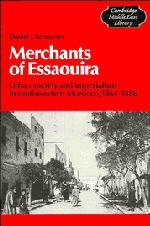Book contents
- Frontmatter
- Contents
- List of illustrations
- Map 1 General map of Morocco
- Preface
- Notes on usage
- Abbreviations
- Chronology
- 1 Introduction
- 2 The royal port
- 3 Merchants of the Sultan
- 4 Port and bazaar
- 5 Beyond the walls
- 6 The politics of trade
- 7 Foreign intervention and domestic reforms
- 8 The struggle for the southwest
- 9 The people of Essaouira in precolonial times
- 10 The end of an era
- Appendix A Corcos collection: nineteenth-century Arabic documents (1843–83)
- Appendix B Population estimates of Essaouira
- Appendix C Balancing revenue and expenditure: accounts of the port
- Appendix D Trade statistics for Essaouira
- Notes
- Bibliography
- Index
2 - The royal port
Published online by Cambridge University Press: 04 August 2010
- Frontmatter
- Contents
- List of illustrations
- Map 1 General map of Morocco
- Preface
- Notes on usage
- Abbreviations
- Chronology
- 1 Introduction
- 2 The royal port
- 3 Merchants of the Sultan
- 4 Port and bazaar
- 5 Beyond the walls
- 6 The politics of trade
- 7 Foreign intervention and domestic reforms
- 8 The struggle for the southwest
- 9 The people of Essaouira in precolonial times
- 10 The end of an era
- Appendix A Corcos collection: nineteenth-century Arabic documents (1843–83)
- Appendix B Population estimates of Essaouira
- Appendix C Balancing revenue and expenditure: accounts of the port
- Appendix D Trade statistics for Essaouira
- Notes
- Bibliography
- Index
Summary
He who comes [to Essaouira] poor, leaves rich.
A saying attributed to Sultan Sīdī Muhammad b. ʿAbdallāh at the time of the foundation of EssaouiraThe situation of Mogadore [Essaouira] is the most desolate that can be imagined, and nothing but the advantages afforded to trade and the superiority of the harbour over the others of the Empire could ever reconcile merchants to an establishment here. An unbroken chain of high sandhills, totally bare of vegetation, meet the eye along the coast, and for miles inland the same aspect is presented, with the exception of here and there, a small cultivated spot, between the hills.
British vice-consul, Mr. GraceIn 1764, the new town of Essaouira was founded by Sultan Sīdī Muhammad b. ʿAbdallāh (1756–80) due west of Marrakesh on the Atlantic coast. It was to be Morocco's main seaport for trade with Europe. The Sultan, as legend suggests, intended to make the port a great and prosperous city where the principal Moroccan merchants could dwell and make fortunes.
Essaouira did indeed become the principal maritime port of Morocco within a decade after its creation, a status it maintained for over a century. But the legendary grandeur of the royal port of Sultan Muhammad III contrasts markedly with the stark reality portrayed by vice-consul Grace.
- Type
- Chapter
- Information
- Merchants of EssaouiraUrban Society and Imperialism in Southwestern Morocco, 1844–1886, pp. 7 - 20Publisher: Cambridge University PressPrint publication year: 1988



